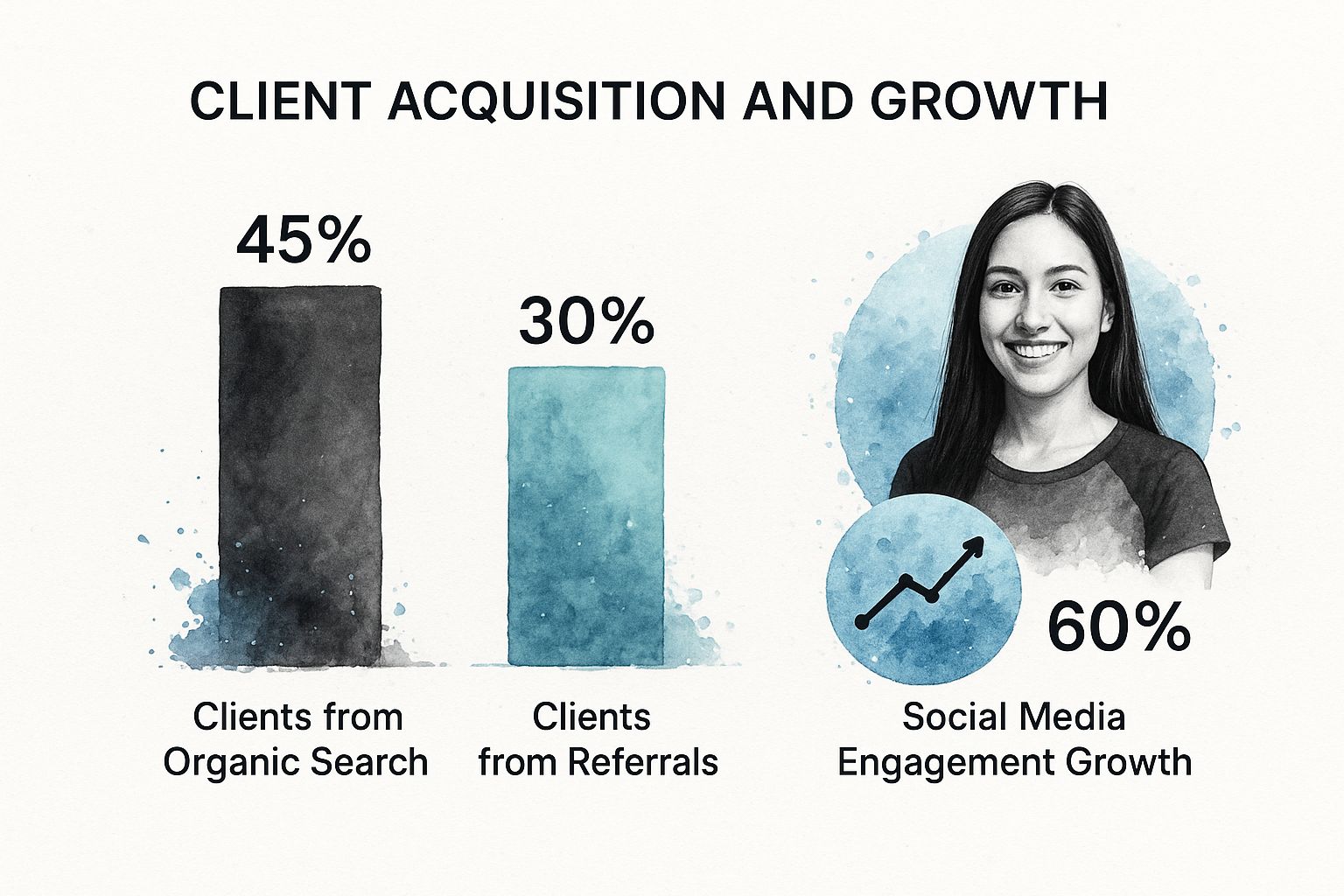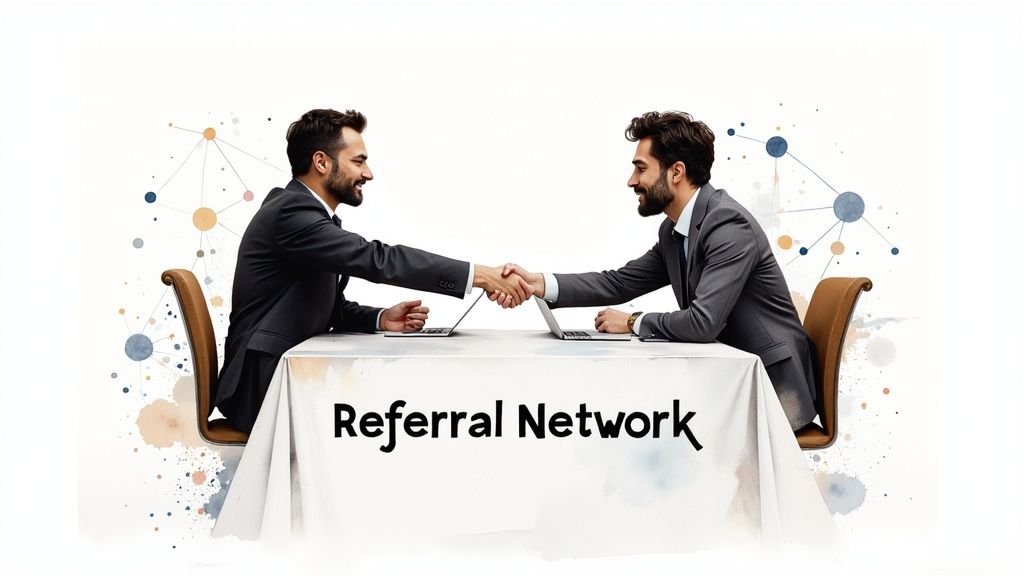If you’re trying to figure out how to get legal clients, the most critical first step is building a solid strategic foundation. This is about more than just having a website or running a few ads; it means getting crystal clear on exactly who you want to serve and how you’ll position your firm to stand out.
Performing this foundational work ensures every marketing dollar you spend is a strategic, results-driven investment.
Building Your Foundation for Client Growth

Before a single ad goes live or an SEO campaign kicks off, the most successful law firms do the same thing: they take a step back and lay the groundwork.
This initial phase isn't about getting a flood of leads tomorrow; it's about drawing a clear map that will guide your firm’s growth. This clarity makes every subsequent marketing effort more powerful and cost-effective. Without it, firms end up wasting significant budget chasing the wrong people or simply blending into the competitive noise.
The process starts with defining your ideal client. Don't stop at broad categories like "personal injury" or "family law." You have to get granular.
- Who are they, really? Go beyond demographics. Think about their mindset—what are their biggest worries and fears? What specific event just happened that triggered their search for a lawyer?
- Where do they spend their time? Consider their specific neighborhood or city, the social media platforms they scroll through, and even the local community groups they might be part of.
- What is their exact problem? A person searching for a "business contract lawyer" has a completely different mindset and set of needs than someone urgently looking for "shareholder dispute litigation."
Think of this ideal client profile as your firm's North Star. It helps you tailor your messaging, select the right marketing channels, and create content that speaks directly to their most pressing problems.
Analyze the Competitive Environment
Once you know who you’re targeting, you need to understand who you’re up against. A competitive analysis isn't about copying other firms; it's about finding opportunities they’ve missed.
Take a hard look at the top-ranking firms in your practice area and city. What is their core message? Which keywords are they targeting online? What do their client reviews reveal? Answering these questions helps you spot their weaknesses and your potential strengths, allowing you to carve out a unique, defensible position in the market.
A Real-World Example: A family law firm in a city saturated with "aggressive" lawyers found a significant gap by positioning themselves around collaborative divorce and mediation. They attracted a completely different—and better—clientele by offering a value proposition the competition had ignored.
Finally, this foundational work demands a crucial mindset shift: you must stop seeing marketing as an expense and start viewing it as a direct investment in your firm's future. The data supports this.
Research consistently shows that high-growth law firms invest heavily in marketing. Firms achieving at least 20% compound annual growth dedicated about 16.5% of their revenue to marketing, while stagnant or no-growth firms spent only 5%.
This makes it clear: strategic spending is what drives real success. You can see the complete research on what high-growth law firms are doing to accelerate in 2025.
Attracting High-Value Cases with Digital Advertising
In a competitive market, you can't just hang out a shingle and wait for the perfect clients to walk through the door. While referrals and organic search are essential, they often lack the one thing a growing firm needs: consistency.
If you're serious about learning how to get legal clients predictably, month after month, you must add digital advertising to your playbook.
Paid ads put your firm directly in front of potential clients the moment they realize they have a problem. This isn't about casting a wide, expensive net and hoping for the best. It's about precision-guided marketing that targets specific people with specific legal issues.
Choosing the Right Advertising Platform
The secret to success is picking the platform where your ideal clients are already spending their time. Each channel serves a different purpose, and the best choice depends entirely on your practice area.
For example, a family law practice focused on divorce could see incredible results on Meta (Facebook and Instagram). Why? These platforms let you target people based on life events and relationship status changes—signals that often precede the search for a lawyer. The ad can be empathetic, speaking directly to the emotional and practical side of a separation.
On the other hand, a corporate lawyer specializing in mergers and acquisitions would find Meta to be a waste of resources. Their audience of C-suite executives and business owners is on LinkedIn. Here, you can target ads by job title, industry, and company size, making it the perfect place to promote high-value B2B legal services.
The most effective digital campaigns match the message, the medium, and the audience. Don't just run ads; create a direct line of communication to the people you are uniquely positioned to help.
To help you decide where to invest your ad dollars, here's a quick comparison of the top platforms for law firms.
Digital Advertising Platform Comparison for Law Firms
This table breaks down the most effective digital advertising platforms for acquiring legal clients, highlighting their strengths, ideal use cases, and typical cost structures.
| Platform | Best For Practice Areas | Audience Targeting | Typical Cost Model | Key Advantage |
|---|---|---|---|---|
| Google Ads | Personal Injury, Criminal Defense, Family Law, Bankruptcy | Keyword-based (high intent) | Pay-Per-Click (PPC) | Captures clients actively seeking a lawyer now. |
| Meta (Facebook/Instagram) | Family Law, Estate Planning, Mass Torts | Demographic, interest & behavior-based | Pay-Per-Impression (CPM) / PPC | Reaches potential clients before they start searching. |
| LinkedIn Ads | Corporate Law, B2B Services, IP, Employment Law | Professional (job title, company, industry) | CPM / PPC | Precision targeting for high-value B2B clients. |
| YouTube Ads | Personal Injury, Brand Building | Demographic, interest & video-based | Cost-Per-View (CPV) | Builds trust and brand recognition through video. |
Choosing the right platform is just the first step. Next, you have to create an ad that actually gets clicked.
Crafting Ads That Connect and Convert
Once you've picked your platform, your success boils down to two things: the ad itself and the landing page you send people to. Your ad copy needs to grab a potential client's attention by speaking directly to their urgent problem. It has to be clear, direct, and focused on their pain point, not just your firm's impressive history.
Here’s how that looks in the real world:
- Google Ads: Someone searching "car accident lawyer near me" is ready to act. Your ad headline should mirror their search—"Top Car Accident Lawyer in Miami"—followed by text that builds confidence, like "No-Fee Guarantee. Get a Free Case Review Today."
- Facebook Ads: A user scrolling their feed might see an ad for a "Free Webinar on Estate Planning." This is a softer, educational approach. It builds trust and captures leads for a probate or estate planning practice.
- LinkedIn Ads: A tech startup founder could see an ad with the headline, "Protect Your IP. Flat-Fee Trademark Services for Startups," which speaks directly to a pressing business need.
The data below shows how different channels contribute to bringing in new clients. It really highlights the need for a multi-channel approach where digital ads work alongside your other marketing efforts.

This visual drives home the point: while organic search and referrals are powerful, a huge chunk of your growth potential is in proactive outreach. That’s exactly where paid advertising shines.
The final piece of this puzzle is your landing page. It absolutely must be a seamless continuation of the ad's promise. This page should have one goal and one goal only: getting the visitor to take action, whether that's filling out a form or calling your office. Strip away all distractions, repeat the key benefits from the ad, and make your call-to-action impossible to miss.
A well-designed strategy from a trusted partner like DigitalAdvertisingDirect.com ensures all these pieces work together, delivering a steady stream of high-quality leads to your firm.
Winning the Search Game with Legal SEO

While paid ads can get the phone ringing almost immediately, Search Engine Optimization (SEO) is the long game. It's the engine that powers sustainable, organic growth for your law firm.
Think of it this way: ranking on the first page of Google is like owning a billboard in the most valuable digital real estate in your city. The best part? You don't pay for every single click. Learning how to get legal clients from search means being the first answer they find when they have a pressing legal question. SEO is the disciplined process of making sure your firm is that answer.
Understanding Your Client’s Search Intent
The bedrock of any solid legal SEO strategy is getting inside your potential client's head. What are they actually typing into Google when they need help? It’s almost never just "lawyer."
Someone going through a messy divorce isn't just searching for a "family lawyer." Their searches are specific, emotional, and urgent. They're typing in things like:
- "Divorce lawyer for men in Phoenix"
- "How is child custody decided in Texas"
- "What to do after a car accident that wasn't my fault"
Uncovering these long-tail keywords is where the real opportunity lies. They reveal the exact problems your clients are trying to solve and signal a much higher intent to hire an attorney.
Your goal shouldn't be to just rank for broad, competitive terms. It's to completely dominate the search results for the specific, painful questions your ideal clients are asking. That's how you get a steady stream of high-quality leads knocking on your virtual door.
Creating Content That Builds Authority
Once you know what your clients are searching for, you have to provide them with genuinely helpful answers. This is where content marketing becomes your most powerful ally. Your website needs to be a valuable resource, not just a digital business card.
This means building out specific pages and blog posts that directly address their pain points. For example, a personal injury firm could publish an in-depth guide on "The Personal Injury Claim Timeline in California." This kind of content does more than just attract traffic; it positions your firm as a credible authority people can trust.
Your content strategy should be a direct extension of your SEO goals. This could look like:
- Detailed Practice Area Pages: Don't just list your services. Dive deep. Explain the legal process, answer the most common questions you get, and showcase your expertise for each practice area, whether it's bankruptcy or criminal defense.
- Hyper-Local Pages: Create dedicated pages targeting the specific cities or even neighborhoods you serve, like "Glendale DUI Attorney" or "Boca Raton Estate Planning."
- Informative Blog Posts: Regularly publish articles that answer real client questions. This tells Google that your site is an active, relevant, and helpful resource in your field.
Mastering Local SEO for Your Firm
For most law firms, clients come from the local community. This makes Local SEO one of the most potent tools in your entire marketing arsenal. The goal is to show up in that coveted "Map Pack"—the box with a map and three business listings that appears at the top of local search results.
Your Google Business Profile (GBP) is the absolute cornerstone of this strategy. It’s often the very first impression a potential client will have of your firm. Optimizing it isn't optional; it's essential.
Make sure your GBP has the correct name, address, phone number, and hours. But don't stop there. Actively manage it by uploading professional photos of your office and team. Most importantly, have a system for consistently gathering client reviews. Those positive reviews are one of the most powerful signals for both local search rankings and client trust. They provide the social proof that convinces a prospect to stop searching and pick up the phone.
For firms that want to connect all these digital touchpoints seamlessly, integrating lead generation with management is key. Exploring a solution like our AdFuel+ system can help tie your SEO and lead management efforts together.
Using Technology and AI for Smarter Acquisition
While traditional marketing builds your foundation, technology is what gives modern law firms a decisive competitive edge. The right tools don't just make you more efficient; they make you more responsive, more organized, and ultimately, far better at turning interested prospects into retained clients.
This isn't about replacing the human element of practicing law. It's about using technology to amplify your reach and perfect the client experience from that very first touchpoint. This strategic approach is a massive differentiator when you're learning how to get legal clients in an incredibly crowded market.
A common mistake is viewing technology as a cost center. Instead, think of it as an investment in operational excellence that pays for itself in client satisfaction and higher conversion rates. The goal is to automate the mundane so you can focus on the meaningful.
Your 24/7 Digital Front Desk
Imagine a potential client lands on your website at 2 AM. They're stressed, perhaps about a recent arrest or a business dispute, and they're looking for answers right now. An AI-powered chatbot can be your firm's first responder, available around the clock.
Modern chatbots are surprisingly sophisticated. They can:
- Engage visitors instantly: They can field common questions about your practice areas, fees, and process.
- Qualify leads automatically: By asking a series of smart, targeted questions, a chatbot can determine if a visitor is a good fit for your firm.
- Schedule consultations directly: This is a game-changer. Qualified leads can book an appointment right on your calendar without ever picking up the phone, preventing them from moving on to the next firm on their Google search list.
This immediate engagement builds trust and ensures you never miss a high-value opportunity, no matter when it comes knocking.
Organizing Your Client Pipeline with a CRM
As leads start flowing in from your website, ads, and SEO efforts, managing them in spreadsheets or your inbox becomes unsustainable. This is where a legal-specific Customer Relationship Management (CRM) system becomes non-negotiable.
Think of a CRM as your firm's central hub for every client and prospect interaction. It allows you to track where each lead came from, what stage they're at in your pipeline, and what the next step should be. This organized approach is what prevents promising leads from falling through the cracks. For instance, you can set up automated, personalized follow-up emails or text messages to nurture prospects who aren't quite ready to commit, keeping your firm top-of-mind.
Looking ahead, artificial intelligence will become even more woven into this process. AI will enable firms to personalize outreach by analyzing data to tailor messages to specific client needs. This makes communication feel more human, allows for quicker responses, and fosters deeper client relationships from day one.
Building a Powerful Referral Network

While digital marketing can keep your pipeline full, some of your highest-quality cases will always come from a source you can't buy: word-of-mouth referrals.
The problem? Most firms treat referrals like a happy accident instead of a core business strategy.
If you're serious about figuring out how to get legal clients and not just one-off wins, you need to build a systematic referral engine. This is about moving beyond just hoping satisfied clients recommend you. It's about strategically building relationships that generate a steady, predictable stream of introductions.
It all starts with turning your happy clients into your most passionate advocates. And that begins and ends with the experience you provide.
- Set Clear Expectations: Right from the first consultation, be crystal clear about the process, realistic timelines, and potential outcomes. Confusion is the enemy of satisfaction.
- Communicate Proactively: Don't make clients chase you for an update. Regular, scheduled communication—even a quick "no new updates, but we're on it" email—shows you're in control and that you respect their peace of mind.
- Deliver on Your Promises: This is the simplest yet most powerful way to earn a referral. Do exceptional legal work and secure the best possible result.
A client who feels heard, respected, and genuinely cared for is infinitely more likely to sing your praises to their friends, family, and colleagues. This is the bedrock of any powerful referral network.
Cultivating Professional Referral Partnerships
Beyond your clients, some of the most untapped potential is sitting right in your professional network. These are the non-competing professionals who serve the same clients you do, just at different stages of their journey.
Take a moment and think: who does your ideal client talk to before or after they need you?
For a family law attorney, that network should include marriage counselors, financial planners, and therapists. A real estate lawyer needs strong ties with realtors, mortgage brokers, and home inspectors.
The goal isn't just to collect business cards. It's to build a small, tight-knit group of trusted advisors who feel completely confident sending their best clients your way—and you, theirs.
To make these relationships stick, you have to provide value first. Send them a referral without asking for anything in return. Share an insightful article you know their clients would appreciate. Offer to co-host a free webinar for their audience.
Show them you're a valuable resource, not just another lawyer with a hand out. This approach transforms a simple contact into a true referral partner who actively looks for opportunities to help you grow.
For more deep-dive strategies on content marketing and building your authority, you'll find a ton of information on our DigitalAdvertisingDirect.com blog. This kind of long-term relationship building is absolutely essential for creating a referral system that pays you back for years.
Turning Your Leads Into Retained Clients
Getting a steady stream of leads is a fantastic milestone, but it’s only half the job. The real work—and where your marketing investment actually pays dividends—begins the second a potential client reaches out. If you want to know how to get legal clients and not just website clicks, you have to perfect your intake and consultation process.
Think about it from their perspective. They have an urgent, often stressful, problem. Your firm’s initial response sets the entire tone. Whether it’s a phone call or an email, it has to be fast, empathetic, and professional. A slow or disorganized reply sends a loud and clear message: their problem isn't your priority. That’s a surefire way to send them straight to your competitor.
Structuring a Consultation That Closes
A great consultation isn't a one-way presentation where you list your credentials. It’s a carefully structured conversation designed to build trust and guide the prospect toward making a decision. Your goal isn't to talk at them; it's to listen, diagnose their issue, and position your firm as the obvious solution.
A powerful consultation almost always flows through these key phases:
- Active Listening: Let them tell their story first. Don't interrupt. Ask open-ended questions to get to the heart of their pain points and what a "win" looks like for them. This immediately shows you care about their unique situation, not just their case type.
- Demonstrating Expertise: Once you have the full picture, connect their problem directly to your experience. Try saying something like, "I handled a very similar business dispute last year, and here’s how we approached it…" This builds incredible confidence without sounding arrogant or pushy.
- Outlining the Path Forward: This is where you bring clarity to their chaos. Clearly explain the immediate next steps, the potential legal strategy you envision, and a transparent breakdown of your fee structure. Removing uncertainty is one of the fastest ways to build trust.
Handling Objections and Following Up
Even after a fantastic consultation, some people will hesitate. It's normal. The most common objections you'll hear revolve around cost and timing. The key is not to get defensive. Address these concerns head-on with confidence, explaining the value your fee represents and, just as importantly, the risks and potential costs of not taking action.
For the prospects who say, "I need to think about it," a systematic follow-up process is absolutely essential. This isn't about pestering them; it's about being helpful. A simple, scheduled email a few days later can be the gentle nudge they need to commit.
This is the critical stage where your marketing efforts finally turn from an expense into real revenue. By treating every single lead with a structured, empathetic process, you dramatically increase the chances of turning their initial interest into a signed retainer agreement.
Frequently Asked Questions About Getting Legal Clients
We get asked a lot of the same questions by lawyers figuring out their client acquisition strategy. Let's tackle some of the most common ones.
How Much Should a Law Firm Spend on Marketing?
There’s no magic number, but a solid benchmark for firms serious about growth is 5-10% of gross revenue. Think of this as the fuel for the strategies that keep a steady stream of leads coming through your door.
Some high-growth firms get even more aggressive, pushing their marketing spend up to 15% to really dominate their market. The best way to start is with a budget you're comfortable with. From there, you must track your return on investment (ROI) and double down on the channels that are actually making the phone ring.
What Is the Fastest Way to Get Legal Clients?
If you need leads right now, paid digital advertising is almost always the quickest route. Platforms like Google Ads or Meta Ads let you get in front of people who are actively looking for legal help at this very moment. A well-managed campaign can be live and generating leads within days.
A personal injury firm, for example, could launch a Google Ads campaign targeting "car accident lawyer near me" and start getting calls almost immediately. That instant visibility is a powerful tool for filling your pipeline fast.
But speed isn't everything. For real, sustainable growth, you need a blended approach. Combining paid ads with long-term plays like SEO and referral marketing builds a much more resilient—and ultimately more cost-effective—client acquisition machine.
Should I Focus on SEO or Paid Ads First?
This really comes down to your firm's immediate needs and goals.
- Go with paid ads first if: You need clients and cash flow now. Paid ads deliver instant visibility and results you can measure, giving your firm a much-needed shot in the arm.
- Focus on SEO if: You're playing the long game and can afford to be patient. SEO is an investment that compounds over time, eventually creating a stream of high-quality, "free" traffic that can become your most profitable source of leads.
The truth is, most successful firms don't just pick one. They use both. They run paid ad campaigns for immediate leads while building out their SEO foundation in the background. It’s a strategy that captures clients today while building a valuable asset for tomorrow.
Ready to stop wondering where your next client will come from and start building a predictable pipeline of high-value cases? DigitalAdvertisingDirect.com specializes in creating and managing custom advertising strategies for law firms. Get a free strategy session today.


